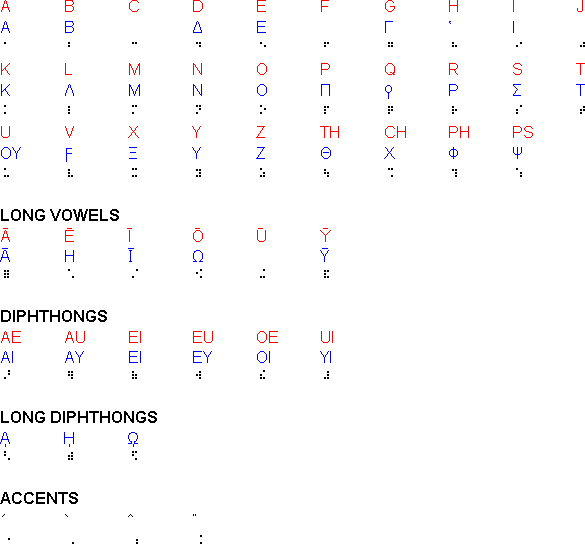Braille for Latin and Greek
Samuel Barnes took three years of Latin in high school, and a
semester of classical Greek in college. However he is now faced
with vision loss and is having a hard time reading print, so
he decided to devise his own method of writing Latin and Greek
with Braille.
At first it was just a code for classical Latin, but he then
rememberd the fact that both Latin and ancient Greek are so closely
connected historically, and that they share much phonology, so he
decided to make a unified code to represent both languages; that way
a student of one could easily begin studying the other.
Braille for Latin and Greek

Notes
- Ideally, for both Latin and Greek, all long vowels should be indicated,
as the difference between long and short vowels often changes the meaning
of a word, like Latin puella = girl (nominative case), and
puellā = by the girl (ablative case).
- For both Latin and Greek, all diphthongs should be presented in contracted form.
- The Latin Letter Q, although always accompanied by a U in print, is
written alone in braille both to save space and to moare accurately indicate
that the sound represented by the print QU was a labialized velar, not a
velar followed by a labiovelar approximate. For example quinque
is rendered qinqe in Braille.
- In Latin print the letter combinations PH, TH, and CH were used to
represent the Greek letters phi, theta, and chi respectively. In Latin
braille, these combinations are always written using their single cell
forms, rather than writing them seperately. For example, the Latin word
thermae (baths) is borrowed from Greek, but, instead of writing the T
and the H seperately in braille, the Greek Theta symbol is used to save
space and to further allude to the word's Greek etymology.
- On a somewhat similar note, the Greek letter psi, which itself does not
occur in printed Latin texts (although see the Claudian Letters), is used
in Latin for all occurences of the sound /ps/ in order to save space. Thus,
for example, the Latin word capsa = box or container, is written using a psi.
- Although the Greek rough breathing is traditionally indicated with a
diacritic in print, in Braille it is indicated by the Latin letter H, and
thus may be considered a seperate letter in Greek braille. The soft breathing
is ignored alltogether, as it was always rather redundant even in printed
Greek. Note also that, since the breathy rho that is written with a dasia
above it only occures at the beginning of a word and in the second place of
a geminated rho, it is not indicated in Greek Braille in order to save space.
- Note that not all of the Braille symbols have both a Latin and a Greek
meaning. (This may change in time).
- Similarly, the Latin letters Q and V corrispond in braille to the obsolete
Greek letters qoppa and Digamma respectively. This is done primarily for
phonetic reasons, as in very ancient times, those letters were used in Greek
to represent a QU and a W sound. These letter ultimately gave rise to the
Latin Q and F respectively. However, Samuel chose to equate the Latin Letter V
to Digamma because they are more phonetically linked, as both V and digamma
were used to write a [w] sound.
- In Latin, the consonants J and V are ALWAYS written distincly from the
vowels I and U. This is done for clarity. For example, one would write janua
(door) instead of ianua, and sum instead of svm.
- Punctuation is indicated as in other braille systems, although
capitalization is in general not recognized, as it was not in ancient times.
However, Samuel may provide a capital sign in the future.
Sample texts
Latin

Greek

Tactile Writing Systems
Braille for Chinese,
Braille for English,
Braille for Latin & Greek,
Braille for Welsh,
Moon,
Fakoo,
Quadoo,
Siekoo
Page last modified: 15.03.22
[top]

You can support this site by Buying Me A Coffee, and if you like what you see on this page, you can use the buttons below to share it with people you know.

If you like this site and find it useful, you can support it by making a donation via PayPal or Patreon, or by contributing in other ways. Omniglot is how I make my living.
Note: all links on this site to Amazon.com , Amazon.co.uk
, Amazon.co.uk and Amazon.fr
and Amazon.fr are affiliate links. This means I earn a commission if you click on any of them and buy something. So by clicking on these links you can help to support this site.
are affiliate links. This means I earn a commission if you click on any of them and buy something. So by clicking on these links you can help to support this site.
[top]




, Amazon.co.uk
and Amazon.fr
are affiliate links. This means I earn a commission if you click on any of them and buy something. So by clicking on these links you can help to support this site.